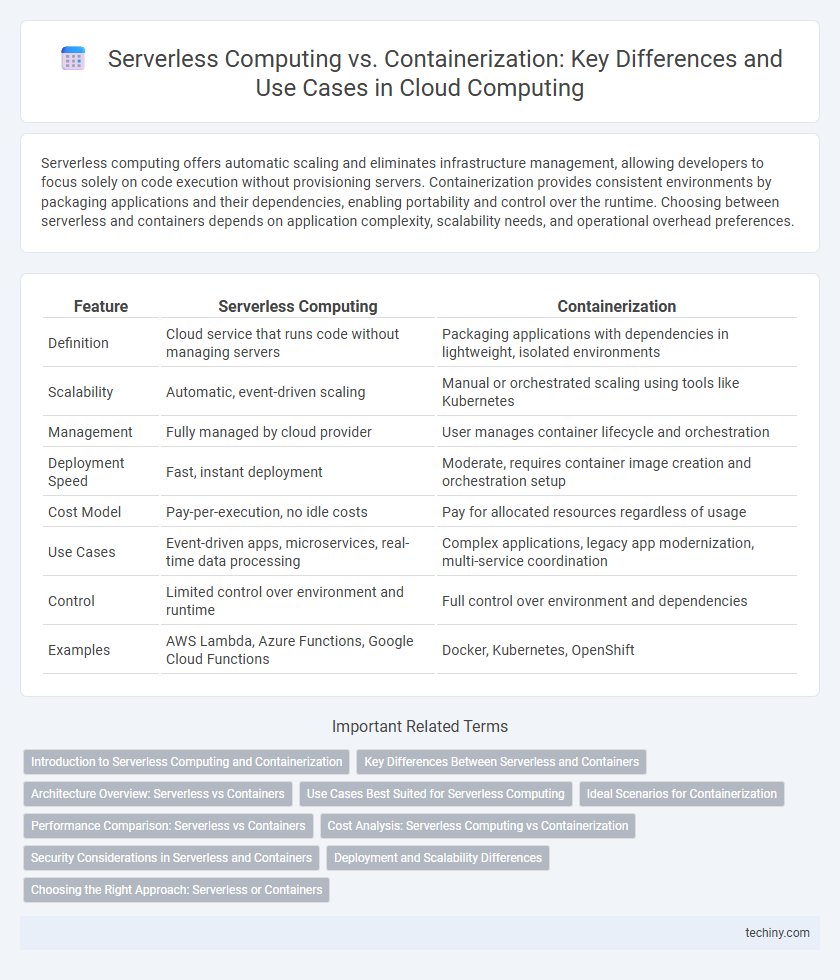Serverless computing offers automatic scaling and eliminates infrastructure management, allowing developers to focus solely on code execution without provisioning servers. Containerization provides consistent environments by packaging applications and their dependencies, enabling portability and control over the runtime. Choosing between serverless and containers depends on application complexity, scalability needs, and operational overhead preferences.
Table of Comparison
| Feature | Serverless Computing | Containerization |
|---|---|---|
| Definition | Cloud service that runs code without managing servers | Packaging applications with dependencies in lightweight, isolated environments |
| Scalability | Automatic, event-driven scaling | Manual or orchestrated scaling using tools like Kubernetes |
| Management | Fully managed by cloud provider | User manages container lifecycle and orchestration |
| Deployment Speed | Fast, instant deployment | Moderate, requires container image creation and orchestration setup |
| Cost Model | Pay-per-execution, no idle costs | Pay for allocated resources regardless of usage |
| Use Cases | Event-driven apps, microservices, real-time data processing | Complex applications, legacy app modernization, multi-service coordination |
| Control | Limited control over environment and runtime | Full control over environment and dependencies |
| Examples | AWS Lambda, Azure Functions, Google Cloud Functions | Docker, Kubernetes, OpenShift |
Introduction to Serverless Computing and Containerization
Serverless computing enables developers to build and run applications without managing infrastructure, automatically scaling resources based on demand while charging only for execution time. Containerization packages applications and their dependencies into lightweight, portable containers that ensure consistent environments across development, testing, and production. Both technologies optimize resource utilization and deployment agility, with serverless focusing on event-driven functions and containerization providing granular control over application environments.
Key Differences Between Serverless and Containers
Serverless computing eliminates the need for infrastructure management by automatically scaling and executing code based on events, whereas containerization involves deploying applications within isolated environments that require manual orchestration and scaling. Serverless platforms charge based on actual execution time, optimizing costs for variable workloads, while containers often incur charges for allocated resources regardless of utilization. Security models differ as serverless abstracts the underlying infrastructure, reducing the attack surface, whereas container security requires diligent management of container images and runtime environments.
Architecture Overview: Serverless vs Containers
Serverless computing abstracts infrastructure management by running code in ephemeral functions triggered by events, enabling automatic scaling and billing based on execution time, while containerization packages applications with their dependencies into isolated, consistent units that run on container orchestration platforms like Kubernetes. Serverless architecture eliminates the need to manage servers, focusing purely on function deployment, whereas container architecture requires managing container lifecycle, orchestration, and underlying host resources. Understanding these architectural distinctions helps organizations choose between event-driven, scalable functions and portable, customizable application environments for cloud-native development.
Use Cases Best Suited for Serverless Computing
Serverless computing excels in applications with unpredictable or highly variable workloads, such as real-time data processing, event-driven architectures, and APIs that require automatic scaling without infrastructure management. It is ideal for microservices, chatbots, mobile backends, and IoT applications due to its ability to quickly deploy and scale functions on demand. Serverless platforms like AWS Lambda and Azure Functions reduce operational overhead, making them the best choice for lightweight, stateless tasks with irregular execution patterns.
Ideal Scenarios for Containerization
Containerization is ideal for complex applications requiring consistent environments across multiple development, testing, and production stages, ensuring portability and scalability. It excels when workloads demand granular control over dependencies and runtime configurations, supporting microservices architectures and hybrid cloud deployments. Enterprises with legacy applications or those needing rapid scaling with minimal overhead benefit significantly from container orchestration platforms like Kubernetes.
Performance Comparison: Serverless vs Containers
Serverless computing offers automatic scaling and event-driven execution, optimizing resource allocation and reducing idle time compared to containerization, which requires manual scaling and resource management. Containers provide consistent performance with predictable latency by maintaining long-running instances, whereas serverless functions may experience cold start delays impacting responsiveness. Performance depends heavily on workload type, with serverless excelling in intermittent or unpredictable bursts and containers better suited for sustained, high-throughput applications.
Cost Analysis: Serverless Computing vs Containerization
Serverless computing reduces operational costs by charging only for actual execution time and scaling automatically, eliminating expenses related to idle infrastructure. Containerization involves fixed costs tied to cluster management and resource allocation regardless of workload, which can increase expenses during low usage periods. For workloads with unpredictable traffic, serverless often offers better cost efficiency, while containerization may provide savings for consistent, high-demand applications.
Security Considerations in Serverless and Containers
Serverless computing offers enhanced security by abstracting infrastructure management, minimizing attack surfaces, and applying automatic patching, though it introduces risks like cold start vulnerabilities and limited control over runtime environments. Containerization provides robust security through isolated environments and customizable runtime configurations, yet it requires diligent management of container images, orchestration tools, and host operating systems to prevent exploits. Both paradigms demand strict identity and access management, continuous security monitoring, and adherence to best practices to mitigate potential threats effectively.
Deployment and Scalability Differences
Serverless computing allows automatic scaling and deployment without managing underlying infrastructure, enabling rapid function execution triggered by events. Containerization requires explicit deployment of container images on orchestrated clusters, giving developers control over environment configuration and resource allocation. Serverless excels in scaling fine-grained workloads on-demand, while containers provide more flexibility for complex, long-running applications with predictable scaling patterns.
Choosing the Right Approach: Serverless or Containers
Serverless computing offers automatic scaling and reduced operational management, making it ideal for event-driven applications with unpredictable workloads. Containerization provides greater control, consistency, and portability, suitable for complex, stateful applications requiring customized environments. Evaluating factors like scalability needs, deployment complexity, cost considerations, and application architecture helps determine whether serverless or containers best align with your cloud strategy.
Serverless Computing vs Containerization Infographic

 techiny.com
techiny.com